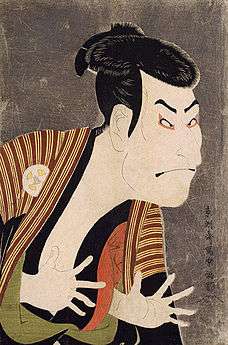Uki-e

Uki-e (浮絵, "floating picture", implying "perspective picture") refers to a genre of ukiyo-e pictures that employs western conventions of linear perspective. Although they never constituted more than a minor genre, pictures in perspective were drawn and printed by Japanese artists from their introduction in the late 1730s through to the mid-nineteenth century.[1]
Around 1739, Okumura Masanobu studied European engravings to learn the rules of perspective. His engravings found their way to Japan either through Dejima or China.[1] Masanobu was the first to apply the term Uki-e to perspective images, and Utagawa Toyoharu fully developed the form in the late 1750s when he produced colored woodblock copies of engravings after Canaletto and Guardi. Toyoharu was also the first to adapt these techniques to Japanese subjects.
The interior of Kabuki theaters was a common subject in Uki-e prints. Interior scenes tend to be favored as it is easier to accurately apply one point perspective to architecture than to landscape.[1]
See also
Citations
References
- Bayou, Hélène (2004). Réunion des musées nationaux, ed. Images du Monde flottant: Peintures et estampes japonaises XVIIe-XVIIIe siècles (in French). ISBN 978-2-7118-4821-8.
- Hockley, Allen (2006). Public Spectacles, Personal Pleasures: four centuries of Japanese prints from a Cincinnati collection. Cincinnati: Cincinnati Art Museum. ISBN 0-931537-29-0.
- Seiichi, Iwao; Teizō Iyanaga (2002). Dictionnaire historique du Japon, Volume 2 (in French). Maisonneuve & Larose.
External links
 Media related to Uki-e at Wikimedia Commons
Media related to Uki-e at Wikimedia Commons- Short article about the genre
